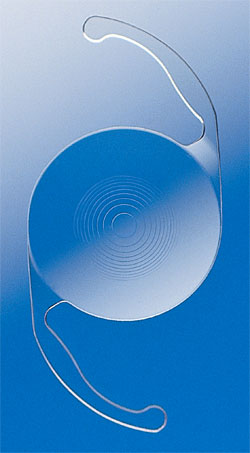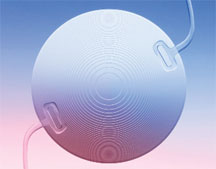When you have a cataract, the lens of your eye becomes cloudy. Light cannot pass through the lens easily, and your vision becomes blurred. During cataract surgery, the ophthalmologist (Eye M.D.) removes the cloudy, natural lens and replaces it with a clear, artificial lens called an intraocular lens (IOL). The IOL helps your eye regain its focusing ability and allows you to see clearly again.
The most common type of IOL is the monofocal or fixed-focus IOL. The monofocal lens helps you attain clearer vision at one distance. Note that eyeglasses and contact lenses are still required in order for you to see clearly at all ranges of distance.
Another type of IOL is the multifocal IOL. The multifocal lens has several rings of different powers built into the lens. The part of the ring you look through will determine if you can see clearly at far, near, or intermediate distances. (Below the Alcon AcrySof ReSTOR on the left and B&L Tecnis IOL on the right.)


A third type of IOL is the accommodative IOL. The accommodative lens has a hinge designed to work with your eye muscles, allowing the lens to move forward as the eye focuses on near objects and backward as the eye focuses on distant objects. This movement allows you to focus clearly at different distances.
Implanting an IOL takes about 20 minutes and is an outpatient procedure. In addition to a preoperative eye exam, your eye surgeon will take some measurements of your eyes and will give you topical or local anesthesia. The surgeon makes a few small incisions close to the edge of the cornea and then inserts a small, ultrasound instrument to break up the center of the eye’s natural lens. The lens is then vacuumed out through one of the incisions. The surgeon folds and inserts the IOL through the same incision. These incisions are usually self-sealing, requiring no stitches. Once implanted, a multifocal or accommodative IOL allows you to focus on near or distant objects.
Risks associated with implanting IOLs include overcorrection or under-correction, infection, increased floaters, retinal detachment, dislocation of the implant, halos, glare, dry eye, decreased contrast sensitivity, clouding of a portion of the IOL, and loss of vision.
If you are going to have cataract surgery, you and your ophthalmologist should discuss which IOL may be best for your vision needs.
(c) 2007 The American Academy of Ophthalmology
